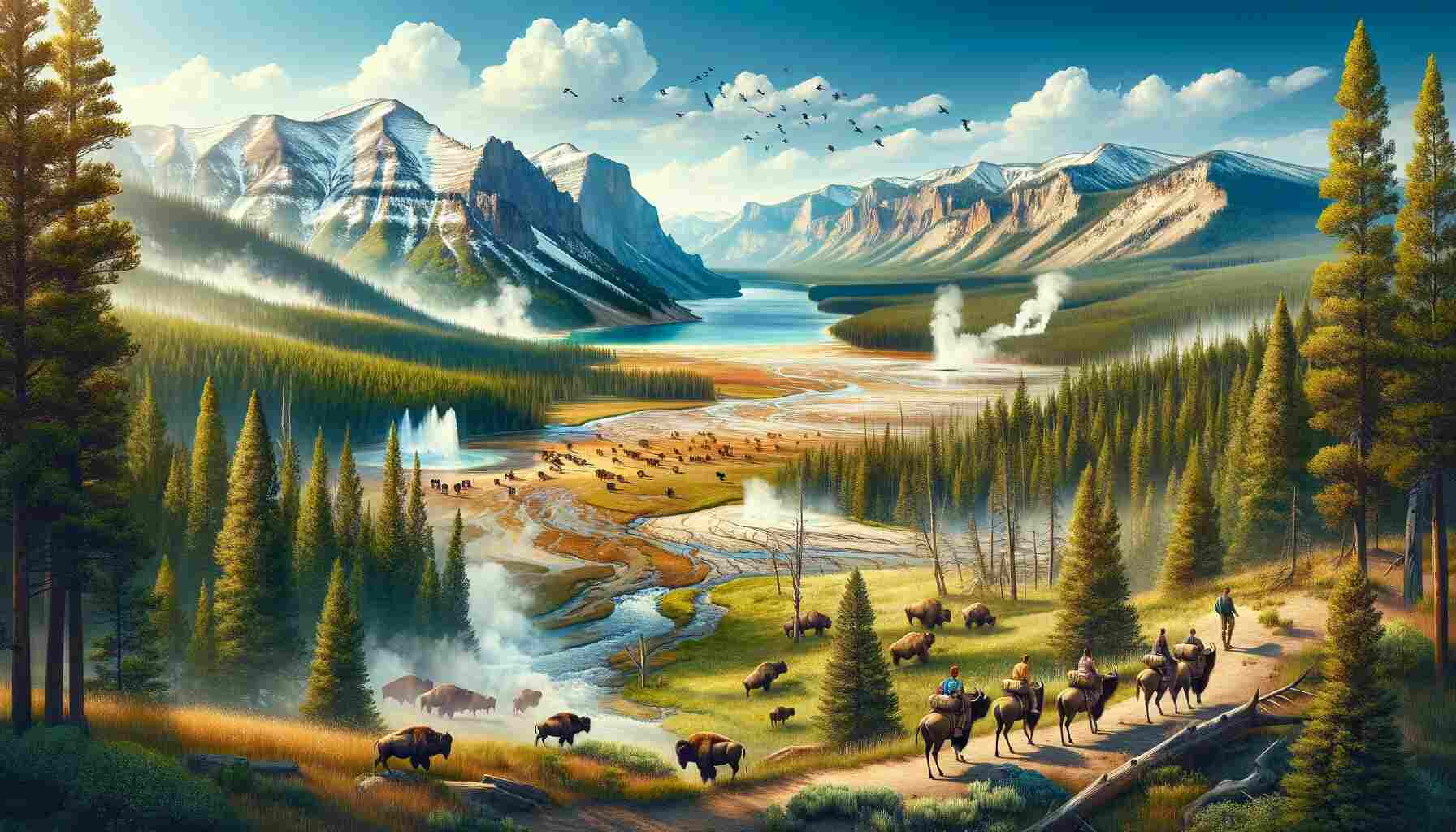Yellowstone National Park is a true natural wonderland, renowned for its stunning landscapes and incredible wildlife. If you’re an outdoor enthusiast looking to experience the park’s diverse fauna up close, you’re in for a treat. In this comprehensive guide, we’ll take you through the best day hikes in Yellowstone to see wildlife. Whether you’re a seasoned hiker or a novice explorer, there’s something for everyone to enjoy while reveling in the beauty of Yellowstone’s wildlife.
Introduction to Yellowstone National Park
Before we delve into the best day hikes, let’s get acquainted with Yellowstone National Park itself. Established in 1872, it holds the distinction of being the first national park in the world. Covering nearly 2.2 million acres, it sprawls across Wyoming, Montana, and Idaho. The park’s diverse ecosystems, geothermal wonders, and abundant wildlife draw millions of visitors every year.
One of the primary reasons to visit Yellowstone is to witness its magnificent wildlife. The park is home to an array of species, including bison, elk, grizzly bears, wolves, and various bird species. With such a rich tapestry of life, it’s no wonder that Yellowstone is a top destination for wildlife enthusiasts.
Now, let’s embark on a journey through the best day hikes in Yellowstone, where you can enjoy the park’s wildlife responsibly.
Best Days and Times for Wildlife Viewing
When planning your wildlife-focused hikes in Yellowstone, consider the following tips for the best chances of sightings:
- Weekdays: Weekdays, especially Tuesdays through Thursdays, tend to be less crowded than weekends. Choosing a weekday for your hike can offer a quieter and more peaceful experience, increasing your chances of wildlife sightings without disturbance.
- Early Mornings: Dawn is often the best time for wildlife viewing. Animals are more active during the cooler hours of the morning, making it easier to spot them. Consider starting your hike as early as possible.
- Late Afternoons: Late afternoons, just before sunset, are another prime time for wildlife activity. Many animals become more active again in the evening, providing excellent opportunities for sightings.
- Best Times by Season: Depending on the season of your visit, certain times are better for specific wildlife encounters. For example, spring is ideal for observing baby animals, while fall is mating season for many species.
- Lunar Phases: Full moon nights can be excellent for nighttime wildlife viewing. The moonlight may make it easier to spot animals like owls, wolves, and other nocturnal creatures.
- Special Events and Programs: Keep an eye out for ranger-led programs and wildlife festivals. These can provide expert guidance on the best times and locations for wildlife sightings.
Remember that wildlife is unpredictable, and there are no guarantees. Patience and a keen eye are essential. Additionally, always follow park regulations and guidelines to ensure your safety and the well-being of the animals you encounter.
Yellowstone’s Wildlife-Rich Trails
1. Lamar Valley Trail
Length: 6 miles (round trip)
Difficulty: Easy
Wildlife: Bison, wolves, elk, pronghorn, and more
Lamar Valley, often referred to as the “Serengeti of North America,” is a prime location for wildlife sightings. The Lamar Valley Trail is a relatively easy hike that meanders alongside the Lamar River. The expansive meadows offer ample opportunities to spot bison, elk, pronghorn, and even wolves if you’re lucky. Early mornings and late evenings are the best times for wildlife viewing here.
2. Mount Washburn Trail
Length: 6.8 miles (round trip)
Difficulty: Moderate
Wildlife: Bighorn sheep, marmots, pikas, and birds of prey
For a mix of stunning vistas and wildlife encounters, the Mount Washburn Trail is an excellent choice. The trail leads to the summit of Mount Washburn, where you can spot bighorn sheep, marmots, pikas, and various birds of prey. The panoramic views of the park from the summit are an added bonus.
3. Hayden Valley Trail
Length: Varies (multiple trails available)
Difficulty: Easy to moderate
Wildlife: Bison, grizzly bears, wolves, and waterfowl
Hayden Valley is another wildlife hotspot in Yellowstone. Unlike Lamar Valley, it’s not just about open meadows but also the Yellowstone River, providing a unique habitat for waterfowl. Multiple trails crisscross this area, offering a range of hiking options. Keep an eye out for bison, grizzly bears, wolves, and the incredible birdlife that inhabits this region.
4. Elephant Back Mountain Trail
Length: 3.5 miles (round trip)
Difficulty: Moderate
Wildlife: Elk, mule deer, and scenic beauty
The Elephant Back Mountain Trail offers a different perspective of Yellowstone’s wildlife. While it’s not the most densely populated with animals, it does provide a serene setting to spot elk and mule deer. What makes this hike special is the opportunity to combine wildlife viewing with breathtaking views of Yellowstone Lake.
5. Trout Lake Trail
Length: 1.2 miles (round trip)
Difficulty: Easy
Wildlife: Cutthroat trout, river otters, and birds
Trout Lake is a hidden gem when it comes to wildlife watching. This short and easy hike leads you to the serene Trout Lake, where you might catch glimpses of cutthroat trout and playful river otters. The surrounding forest is also home to a variety of bird species, making it a peaceful and rewarding hike for nature enthusiasts.
6. Specimen Ridge Trail
Length: Varies (multiple trails available)
Difficulty: Moderate to challenging
Wildlife: Bighorn sheep, wolves, coyotes, and fossils
Specimen Ridge is not just about wildlife; it’s also an opportunity to step back in time. This hike offers a chance to see fossils from the ancient past, including petrified trees. While exploring the ridges and canyons, you might encounter bighorn sheep, wolves, and even coyotes. It’s a hike that combines natural history with wildlife spotting.
7. Storm Point Trail
Length: 2.3 miles (round trip)
Difficulty: Easy
Wildlife: Waterfowl, gulls, and scenic beauty
Located along the shores of Yellowstone Lake, Storm Point Trail is an easy hike that rewards you with beautiful lake views. While not known for large mammals, this area is rich in waterfowl and gulls. It’s an ideal spot for birdwatchers and those looking for a tranquil lakeside experience.
8. Slough Creek Trail
Length: Varies (multiple trails available)
Difficulty: Moderate
Wildlife: Wolves, black bears, coyotes, and waterfowl
Slough Creek is synonymous with wolf watching in Yellowstone. This area is known for its wolf packs, and hiking along the Slough Creek Trail can offer you a chance to see these elusive predators. Additionally, keep an eye out for black bears, coyotes, and waterfowl in this picturesque valley.
9. Blacktail Plateau Trail
Length: Varies (multiple trails available)
Difficulty: Easy to moderate
Wildlife: Bison, mule deer, and scenic beauty
The Blacktail Plateau Trail is an excellent choice for those seeking a combination of wildlife and scenic beauty. While hiking, you’ll have opportunities to spot bison and mule deer. The expansive plateaus and valleys provide breathtaking views of the park’s diverse landscapes.
10. Wraith Falls Trail
Length: 0.8 miles (round trip)
Difficulty: Easy
Wildlife: Birds, and possibly black bears
Our final recommendation is the short and sweet Wraith Falls Trail. While it’s not known for large mammals, the trail is perfect for birdwatching. Keep an eye out for various bird species, and you might even have a chance encounter with a black bear, although it’s less common.
Wildlife Etiquette
As you venture into Yellowstone’s wilderness, always prioritize the safety and well-being of the animals. Here are some essential wildlife etiquette tips to follow:
- Maintain a safe distance: Use binoculars or telephoto lenses for close-up views, but never approach wildlife closely.
- Keep quiet: Wildlife is easily startled, so maintain a hushed conversation volume.
- No feeding: Feeding wildlife can disrupt their natural behavior and harm their health.
- Stay on designated trails: This helps protect both you and the fragile ecosystems of the park.
- Carry bear spray: In bear country, carrying bear spray and knowing how to use it is essential for safety.
Wildlife Safety and Respect
Before embarking on any wildlife-watching adventure, it’s crucial to remember that Yellowstone’s animals are wild and unpredictable. Respecting their space and following safety guidelines is paramount for both your safety and the animals’ well-being. Keep a safe distance, don’t feed them, and never approach them too closely.
Conclusion
Yellowstone National Park offers a unique opportunity to connect with the natural world and witness its awe-inspiring wildlife. From bison to wolves, elk to eagles, the park’s inhabitants never fail to impress. Remember, though, that they are the true stewards of this land, and our role is to observe and appreciate from a respectful distance.
So, pack your hiking gear, grab your camera, and embark on these unforgettable day hikes to see Yellowstone’s wildlife wonders. By adhering to responsible wildlife-watching practices, you can make the most of your Yellowstone adventure while ensuring the safety and preservation of this extraordinary wilderness.










